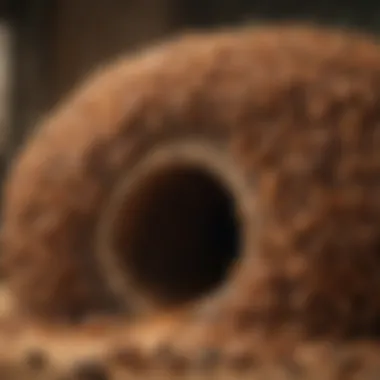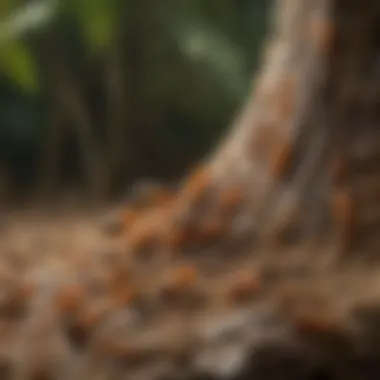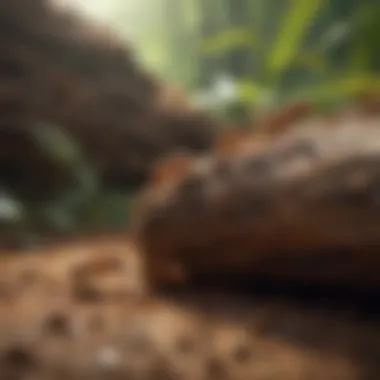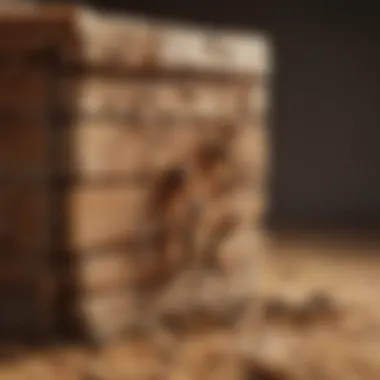Understanding Termites: Their Role and Management


Intro
Termites are often seen merely as pests, but their role in the ecosystem is far more complex and significant. This article aims to unravel the intricacies of these creatures, delving into their ecological contributions, varying species, and effective management techniques. Understanding termites is essential not only for preventing damage to structures but also for appreciating their essential role in ecological systems.
Fascinating Facts About the Animal
Unique Characteristics
Termites belong to the order Isoptera, and their soft bodies are quite different from many other insects. They have a segmented body consisting of a head, thorax, and abdomen. One notable trait of termites is the presence of a unique caste system consisting of workers, soldiers, and reproductive individuals, commonly referred to as kings and queens. Each caste plays a distinct role within the colony, ensuring its survival and efficiency.
Extraordinary Abilities
Termites are remarkable decomposers, primarily due to their ability to break down cellulose found in wood and plant matter. This capability is supported by symbiotic protozoa living in their guts, which help digest this complex material. Beyond decomposition, termite activities facilitate nutrient cycling in ecosystems, promoting healthy soil. Their tunneling also aids in aeration and water infiltration, which benefits plant growth.
Prolusion to Termites
Termites play a significant role in both ecosystems and human environments. Understanding termites is crucial as it sheds light on their diverse nature and the essential functions they serve. This section introduces the fundamental characteristics of termites and their relevance in our world, laying the foundation for further exploration of their biological traits and ecological impact.
Defining Termites
Termites are social insects belonging to the order Isoptera. They are often referred to as “wood-eating” organisms due to their diet primarily consisting of cellulose found in wood and plant matter. This unique ability to break down complex plant materials makes them important decomposers in their ecosystems. There are approximately 3,000 known species of termites worldwide, but only a small fraction of these are known to cause structural damage to buildings. Their social structure is fascinating, as they live in colonies that can number in the millions. Each colony works like a single organism, with individuals specializing in roles to ensure survival and reproduction.
Evolutionary Background
The evolutionary history of termites is complex, dating back over 250 million years. Initially, termites were considered a type of cockroach before undergoing significant evolution. They adapted to a life in colonies, which allowed for cooperative behaviors and division of labor. The relationship between termites and bacteria in their guts is especially notable; this symbiotic relationship enables them to digest cellulose, a capability not present in many other organisms.
More recent studies suggest that termites evolved from wood-feeding ancestors, which contributed to their current ecological roles. Today, termites are found in various habitats, including tropical forests, savannas, and even arid regions. This adaptability highlights their resilience and ecological importance, making them a subject of ongoing research.
The evolutionary history of termites reflects their adaptation and success as ecological engineers, influencing many aspects of the environments they inhabit.
Biological Characteristics of Termites
The biological characteristics of termites are critical to understanding their life cycle, behavior, and ecological roles. These characteristics define how termites interact with their environment, other species, and even humans. A thorough examination of these traits helps highlight their importance in ecosystems and structures they inhabit.
Anatomy and Physiology
Termites possess a unique anatomical structure that is adapted for their lifestyle. They have a hard exoskeleton made of chitin, which protects them from predators and desiccation. Their body is divided into three main segments: the head, thorax, and abdomen. The head houses important sensory organs and mandibles, used for chewing wood and other plant materials.
The physiology of termites includes specialized organs for digesting cellulose, which is abundant in their primary food source, wood. They rely on symbiotic microorganisms that reside in their guts, allowing them to break down cellulose into simpler sugars. This mutualistic relationship with these microorganisms is essential for their survival and biological success.
Social Structure and Behavior
Termites exhibit a sophisticated social structure that is fundamental to their survival and efficiency as a colony. Their behaviors are learned and shared through a combination of pheromonal communication, tactile interactions, and sometimes even vibrations. This organized social life contributes significantly to tasks such as foraging, nest construction, and defense.
Colony Organization
Colony organization is a hallmark of termite societies. Each colony functions as a single entity with various castes, which perform specific roles. The primary caste consists of reproductives, workers, and soldiers. This division of labor enables efficient resource allocation and maximizes the colony's chances of survival.
A key characteristic of colony organization is its adaptability. For example, when a threat is detected, workers can quickly mobilize soldiers to defend the colony. This responsiveness is particularly beneficial, allowing the colony to react swiftly to environmental changes or threats, which is critical for its longevity.
Role of Queen, King, Soldiers, and Workers
The roles within a termite colony are distinct and well-defined. The queen and king are the reproductive pair and play a pivotal role in ensuring colony growth. They can produce thousands of offspring, ensuring continuity.
In contrast, the workers are tasked with foraging for food, maintaining the nest, and caring for the young. Soldiers are equipped with larger mandibles, designed to protect the colony from predators. This hierarchical structure is advantageous as it allows the colony to function efficiently and adapt to changing environments. Each cast contributes uniquely to the welfare of the colony.


Understanding the biological characteristics of termites not only highlights their complex social structures but also underscores their ecological importance.
The study of these aspects is essential for effective management strategies in environments where termites are viewed as pests. Their intricate anatomy and social dynamics offer profound insights into their role in nature and our built environments.
Types of Termites
Understanding the different types of termites is essential for various reasons. First, distinct species possess unique behaviors and habitats, making it crucial for both ecological study and property management. By examining termite types, we can gain insights into their specific roles in ecosystems, their threats to human structures, and effective management strategies. Each type has certain characteristics that influence its interactions with the environment and other organisms.
Subterranean Termites
Subterranean termites are among the most destructive species. They create extensive tunnels underground, making their presence often unknown until significant damage has occurred. These termites primarily feed on cellulose found in wood, leaves, and the soil.
One key aspect of subterranean termites is their colony structure. Typically, they live in large colonies, often numbering in the millions. This size allows them to consume considerable amounts of wood and other materials. Their foraging behavior is coordinated, enabling them to transport food efficiently back to their colony.
Managing subterranean termites often involves physical barriers and chemical treatments to protect structures. Regular inspection and preventive measures can be essential to mitigate the risks associated with infestations. The presence of moisture near a structure can increase the likelihood of an infestation, so addressing moisture levels becomes part of effective control strategies.
Drywood Termites
Drywood termites differ from their subterranean counterparts as they do not require contact with soil. They infest wood directly, making them more challenging to detect until structural damage becomes visible. These termites can live within the wood they infest, leading to their designation as
Ecological Role of Termites
The ecological significance of termites cannot be overlooked. These small, largely misunderstood insects fulfill critical functions within the ecosystems they inhabit. Their role as both decomposers and soil aerators is essential for maintaining the health and productivity of many environments. A solid comprehension of this role helps to underscore their importance in natural processes, affording insights into sustainable management practices.
Decomposers in Ecosystems
Termites are remarkable decomposers. They primarily consume cellulose, which is found in wood, dead plant matter, and other organic materials. This ability to break down cellulose-rich materials allows them to convert dead biomass into nutrient-rich humus, thus returning essential nutrients back into the soil.
Some of the benefits of termite decomposition include:
- Nutrient Cycling: As termites digest wood and plant matter, they release minerals and nutrients like nitrogen, phosphorus, and potassium. This process enriches the soil, promoting healthier plant growth.
- Waste Reduction: By breaking down dead plant material, termites help to mitigate waste accumulation in forests and grasslands, contributing to a cleaner environment.
- Biodiversity Support: The humus and nutrients generated by termite activity provide a foundation for various plant species, fostering increased biodiversity within ecosystems.
In summary, termites are integral to decomposing organic matter, which is vital for sustaining life in various habitats.
Soil Aeration and Nutrient Recycling
In addition to their role as decomposers, termites contribute to soil aeration. They construct intricate tunnel systems that allow air and water to penetrate the soil more effectively. This aeration process is crucial because it:
- Improves Soil Structure: Termite activities help to create channels in the soil. These channels enhance water infiltration and reduce surface runoff, which is vital for healthy plant growth.
- Supports Microbial Life: Improved aeration provides microorganisms access to oxygen, leading to increased microbial activity. This facilitates further nutrient cycling and contributes to soil health.
- Prevents Soil Compaction: With constantly moving through the soil, termites help to prevent compaction. Healthy soil structure benefits root systems, allowing plants to absorb water and nutrients more efficiently.
Without termites, many ecosystems would see a decline in soil health, adversely affecting the entire food web.
Influence on Plant Growth
Termites play a significant role in promoting and supporting plant growth. By recycling nutrients and aerating the soil, they create favorable conditions for plants in the surrounding areas. Some influences termites have on plant growth include:
- Enhanced Nutrient Availability: The nutrients released during termite decomposition of wood and other organic materials increase the availability of essential elements for plants, which fosters vigorous growth.
- Soil Moisture Retention: Their tunneling activities improve soil structure, which helps maintain moisture levels. Healthier soils retain water better, providing plants with the hydration they need to thrive.
- Stimulation of Plant Diversity: Healthier soils promote a wider variety of plant species, as more nutrients and better growing conditions allow for diverse flora to flourish.
Termites are not merely pests; they are vital players in our ecosystems, ensuring that nutrients cycle and that our soils remain healthy and productive.
Termites and Human Structures
Termites pose a significant challenge to human structures. The interplay between these insects and buildings illustrates the need for understanding termite behavior. Affected structures experience deterioration over time, with implications that reach beyond aesthetics. Recognizing the threat is crucial for effective management strategies. The overall goal is to protect investments and maintain safety in habitats where these pests are prevalent.
Impact on Buildings and Infrastructure


Termites, especially subterranean varieties, are notorious for their impact on buildings. They tunnel through wood and other materials, leading to structural weaknesses. This damage often goes unnoticed until it is severe. The signs can be subtle, like small openings or mud tubes, which makes early detection difficult. It is not just wooden structures that are affected. Termites can also impact concrete foundations and other materials indirectly by causing moisture issues.
Researchers estimate that billions of dollars are spent each year on termite control and repairs. In regions where termites are common, homeowners must be proactive. Regular inspections and treatments can be beneficial in preventing infestations before they start.
"The presence of termites can undermine a building's integrity long before visible signs appear."
The types of damage that termites inflict may be categorized into several groups:
- Structural Damage: Weakening supports within the building.
- Aesthetic Damage: Visible signs of infestation, such as peeling paint or hollow-sounding wood.
- Foundation Issues: Compromising the soil structure around a building.
Understanding the impact on infrastructure can lead to better design choices. This could involve using materials that are less attractive to termites or incorporating physical barriers.
Economic Consequences of Infestations
Infestations have notable economic consequences, affecting homeowners and businesses alike. The cost of mitigating termite damage can be staggering. Repair bills often exceed thousands of dollars, which may not only involve structure repair but also related issues like mold and pest control. These costs can lead to financial strain, particularly for families unaware of termite risks.
Businesses also suffer. A termite infestation can damage a building's reputation. Customers may hesitate to engage with businesses known to have pest issues. Moreover, the loss of inventory in affected areas adds to the financial burden. In industries like agriculture, termites can further threaten crops, leading to larger economic impacts for farmers.
Effective management strategies can reduce these economic consequences. This includes termite prevention education for homeowners and regular maintenance checks. Investing in preventive measures is often more cost-effective than dealing with severe damage after an infestation is allowed to take root.
Managing Termite Infestations
Managing termite infestations is critical not only for safeguarding structural integrity but also for protecting financial investments. Termites can be insidious, often going undetected until the damage is severe. Therefore, understanding how to manage these pests effectively allows homeowners and property managers to take proactive steps. This section explores preventive measures, treatment options, and tailored solutions to ensure thorough management of termite issues.
Preventive Measures
Preventing termite infestations is usually the first line of defense. Consistent maintenance of the environment around a property can significantly reduce the risk of these pests establishing a colony. Key preventive measures include:
- Moisture Control: Keeping areas around structures dry is vital. This means repairing leaking pipes, ensuring proper drainage and sealing gaps in foundations.
- Wood Treatment: Using pressure-treated wood for construction can help deter termites. Many of these formulations contain insecticides that inhibit termite activity.
- Regular Inspections: Scheduling routine inspections by professionals is advisable. Early detection of termite activity can lead to easier treatment.
Establishing these preventive measures contributes to long-term termite management strategies.
Treatment Options and Solutions
When infestations occur, treatment options need to be considered. Each method has its characteristics and can be tailored to specific needs and situations. Several noteworthy options include chemical treatments, biological methods, and the installation of physical barriers.
Chemical Treatments
Chemical treatments involve the application of insecticides designed specifically for termites. These products are widely used due to their effectiveness in exterminating these pests. The key characteristic is their rapid action, which is beneficial for immediate control of infestations. One unique feature of chemical treatments is their long-term residual effect, meaning they can prevent future invasions.
However, there are also disadvantages to consider. Chemical treatments can be harmful to the environment and may pose risks to non-target organisms, including pets and humans. Careful consideration of application methods and the environment is crucial when choosing this solution.
Biological Methods
Biological methods involve using natural organisms to control termite populations. This approach can be very effective and has gained popularity due to its eco-friendliness. One significant advantage is that biological treatments often have fewer harmful side effects compared to chemical solutions. A unique characteristic of biological methods is they can target specific pests while minimizing impact on other organisms.
Nevertheless, biological methods usually require more time to take effect compared to chemical treatments. Those considering this option must be patient and committed to the process.
Physical Barriers
Physical barriers include various methods designed to prevent termites from accessing structures. This could involve using steel mesh or concrete that is strategically placed to block entry points. The key characteristic of physical barriers is their durability and effectiveness in preventing infestations from occurring in the first place. Their long-term nature makes them a wise investment for new constructions.
However, the major disadvantage is that installation can be labor-intensive and costly initially. Homeowners should weigh these factors when integrating physical barriers into their termite management strategies.
Effective management of termite infestations requires a multi-faceted approach, combining prevention with targeted treatment options tailored to specific situations.


Understanding these diverse strategies enables homeowners to adopt informed approaches to managing termites. With a comprehensive management plan that incorporates preventive measures and treatment options, it is possible to minimize the impact of these pests on property and resources.
Research on Termites
Research on termites is a vital component of understanding their role within ecosystems and their impact on human environments. By studying termites, scientists reveal their complex behaviors and interactions, which can inform better management practices. This knowledge is crucial for those who deal with infestations and ecosystem management, such as veterinarians, wildlife biologists, and homeowners.
Ongoing research uncovers the remarkable adaptability of termites to their habitats and challenges. These findings not only enhance our comprehension of their biology but also shed light on their influence in various environments. The benefits derived from termite research go beyond simple pest control; it encompasses broader ecological insights concerning decomposition, soil health, and climate implications.
Recent Findings in Termite Behavior
Recent studies have highlighted the intricate social structures and communication methods employed by termites. Research indicates that certain species possess the ability to recognize pheromonal signals that influence group behavior. This recognition allows colonies to coordinate activities such as foraging, nest defense, and waste management more efficiently.
Additionally, studies reveal a connection between environmental changes and termite behavior. Termites exhibit adaptive behaviors in response to shifts in temperature and moisture levels, which are critical for their survival. These findings support the idea that termites are not only passive organisms within their environments but rather active participants in shaping their ecosystem.
Effective management strategies can benefit from these insights, as understanding their behavior can lead to more targeted and sustainable approaches to controlling infestations. The adaptability observed in termites may also provide further implications for ecological resilience in changing climates.
Termites in Climate Studies
The role of termites in climate studies has garnered increasing attention over recent years. Their activities significantly influence soil carbon dynamics, as they aid in the decomposition of organic materials. Termites break down cellulose-rich plant matter, enhancing nutrient cycling and soil fertility. This activity contributes to carbon sequestration, which is vital for mitigating climate change.
Researchers have focused on how termite populations may shift in response to climate variations. Alterations in temperature and humidity levels can impact their distribution and densities, thus altering their ecological functions. Studying these relationships helps predict how climate change may affect not just termite populations, but also the ecosystems they inhabit.
As scientists continue to explore the interaction between termites and climate factors, they contribute to a more comprehensive understanding of ecosystem service dynamics. This knowledge is crucial for informing conservation strategies and ecosystem management in an era of rapid environmental change. Understanding termites’ roles in climate studies underscores their importance on a much larger ecological stage.
In summary, termite research is critical for revealing insights into their ecological roles and implications for climate health. By grasping their behaviors and contributions, we can adopt more strategic approaches to both management and conservation efforts.
Termites in Culture and Society
The topic of termites in culture and society holds significant relevance in understanding how these insects are perceived and represented throughout human history. Their roles are not just ecological; they expand into realms of folklore, art, and literature, influencing human thought and cultural expression. This relationship can shed light on broader human attitudes towards nature and highlight our complex interactions with the ecosystem.
Mythology and Symbolism
Termites have often been embedded in various mythologies, symbolizing diverse concepts ranging from diligence to destruction. In some cultures, termites represent industriousness. Their incessant work in building intricate tunnels and colonies can be seen as a metaphor for hard work and community effort. In several African cultures, termites are seen as a symbol of perseverance and productivity.
Conversely, their destructive capabilities are also acknowledged. In many stories, they serve as warnings against neglect and the dangers of ignoring foundational issues. This duality in symbolism reflects a common human experience of admiration and fear towards nature’s creatures. For example, the image of the termite can represent chaos and disorder when it invades human dwellings. This understanding reframes our perceptions of termites, positioning them as both creators and destroyers in nature’s narratives.
Termites in Literature and Art
The presence of termites in literature and art often mirrors deeper themes of civilization and nature's cycle. Writers have used termites as symbols to explore issues of decay, rebirth, and the inevitable turnover inherent in life. In literary works, termites may serve as a device to illustrate the fragility of human constructs against time and nature. The wear and tear that termites inflict on manmade structures can symbolize the transient nature of human achievements and the omnipresence of natural forces.
In art, termites have inspired various representations, sometimes illustrating their intricate structures, while other times showcasing the devastation they cause. Sculptors and painters may seek to capture the dual nature of termites, emphasizing their significance in understanding both ecological balance and human vulnerabilities.
“Termites stand as a profound reminder of nature's relentless progress, whether through construction or destruction.”
Through these artistic expressions, termites prompt reflection on our societal values, our dependence on nature, and the lessons we may glean from observing these small but impactful creatures. As cultures evolve, the representation of termites continues to highlight the complex interplay between humanity and the environment, ensuring their presence in cultural dialogues around nature and existence.
Finale
The study of termites encompasses multifaceted roles and impacts that are essential to comprehend for both ecological and practical reasons. This article highlights the significance of termites, not only as vital components of their ecosystems but also as entities of concern for human habitation.
Summary of Key Points
- Ecological Importance: Termites perform crucial roles in decomposition and nutrient recycling. They assist in soil aeration, enhancing plant growth.
- Types of Termites: Understanding the different species, such as subterranean, drywood, and dampwood termites, is important for targeted management strategies.
- Human Interaction: Infestations can lead to significant structural damage, with economic consequences that underscore the need for effective management practices.
- Management Strategies: Various methods, including preventive measures and treatment options, can mitigate the impact of termite infestations effectively.
- Cultural Significance: Termites also feature significantly in mythology, literature, and art, reflecting their complex relationship with human societies.
Future Implications for Research and Management
Future research can focus on several pertinent areas, such as:
- Behavioral Studies: Investigating termite behavior in changing environmental conditions can lead to improved management techniques.
- Impact on Biodiversity: The relationship between termites and other organisms in their environment presents opportunities for understanding biodiversity better.
- Climate Change Research: Understanding how termites contribute to climate dynamics is crucial. Assessing their role in carbon cycling will be an essential factor in climate models.
- Innovative Management Practices: Developing new eco-friendly treatment options, including biological methods and advanced physical barriers, may lead to more sustainable management.
The insights presented about termites not only inform practical approaches for managing their populations but also encourage appreciation for their ecological roles. It is vital to foster continued inquiry into their behaviors and ecosystems as we explore sustainable solutions for coexistence.







